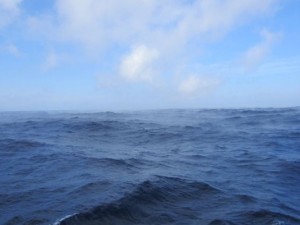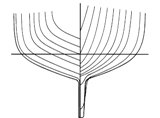2014 Entering the Caribbean
Malua is provisioned. The new crew Christine is aboard and we are
ready to checkout of the USA which is done by phone however it was a
long weekend - Presidents Day so no Government office was open to take
my call. Eventually I found a number in Maryland that had a recording
so I left the details. If they spent an equal effort on exit as entry
the Americans would have a balanced system. Say no more.
We left Portsmouth in overcast conditions and a bitterly cold wind from
the north but after a few hours we turned down the channel and past the
breakwaters and the wind turned on our beam.

What a relief but the autopilot was
playing up when the sails where not set correctly. We sailed
south down the Virginian coast towards the infamous Cape
Hatteras. We were just out of sight of land through the dull and
misty conditions but I could see our tracks on the plotter. The
first night was a lot warmer than I had expected and the sea quite
calm. I had decided to stay close to the mainland and follow the
coast south until I reached Cape Hatteras then turn south east and try
to cut across the Gulf Stream. As the sun set the true cold
descended on us. I was well dressed but the crew assured me she
had suitable thermal layers but still insisted in taking her blanket
into the cockpit. It was becoming clear to me that she had little
real experience so I stayed in the cockpit during her watch.
At dawn the sun tried to come through the low blanket cloud. We
where approaching the Gulf Stream.

The water was still cold in the 10 C range. Then we hit the real
warm water flowing north. The water temp jumped almost ten
degrees and along with it the mist and the short chop of wind against
current: the seafarers worst nightmare. Malua handled the
conditions well under power but the short period between the waves
meant that we took quite a lot of water over the bow. Thankfully
it washed off the decks before it got to the hard dogger.
Water inflow
At the 0800 the Magellan net started. Most of the vessel where
under way spread over the Caribbean. I called in and stated that
we where making good progress south after a hard time getting into the
Gulf Stream. Malua had hit a short chop and the water was still
coming over the bow. I left the radio and moved forward to check
the vessel. As I stepped into the forward cabin my leg went up to
the knee in ice cold water. The cabin was flooded and water was
coming in from the forward head. It was rushing in. I
returned to the radio and called the controller to please stand bye
there was uncontrolled sea water entering Malua. There was a
collective gasp as those listening realised my predicament.
I returned to the forward head believing the water was coming from a
burst through hull. I first had to take all the sails out of the
head, then the other things stored forward. The water was still
streaming in from behind the head where the pipes are connected.
I could not see so had to get the underwater torch/flashlight to shine
the light through the water to see the through hull. I pulled and
pushed and all seemed to be OK. I then opened the cupboard door
above the head and there found a breather pipe coming from the chain
locker streaming water, Yes a two inch pipe with three pressure
hoses through it but streaming water. I had found the source of
the water and it was above the water line. I contacted the net
controller and stated that the water source had been found, the pumps
where holding the water level all I had to do was stop the water coming
in. Quite simple in fact. I had stored two large fender in
the chain locker. As Malua had pushed through the short sea a few
waves had come over the bow and filled the self draining locker with
water. The fenders had floated up and forced the hatch open, in
came the water faster than the self draining holes could exit the
water. OK, remove the fenders secure the hatch cover and wait for
the water to drain. It did not take very long to drain the anchor
locker and with that the breather pipe came clear of the water and the
water stopped coming into the forward head. I forced a rag into the
gaps, hopefully impeding any future water flow.
Now to clean up the mess. Open the drain hole into the bilge and
bail the water out of the forward cabin (which does not have a drain to
the bilge) and get the wet sail off the bunk back onto the floor. What
a mess. Everything was wet with cold cold water. It took a few
sessions to clear and dry the mess but there was no change of opening
the hatches at this stage due to the cloudy weather and the unsettled
sea.
Storm
The following morning on the Magellan net our weather forecaster Mark
warned me of an impending storm. “Don't worry it will arrive
later today but only last 12 hours.” Great news but what can you
do when you are far from land. Prepare all the systems get a good
wind angle and go with the flow. We were no under the wind vane and
having the wind on the beam made Malua romp along which we did all day
under cloudy conditions. I did not trust the new crew even though
she stood watch I was up almost every hour just to check.
Autopilot
The day dawned and I set about solving the autohelm problem as the sea
subsided and the wind dropped. I had been through all the obvious
settings issues regarding sea state, conditions and response times and
that had not improved the situation. I had also checked the
connections in the obvious positions there was only one connection left
to check and that was right next to the drive unit under the aft
lazzerete. I had to crawl over the generator and stretch to the
port to reach the wires which are in-cased in shrink wrap shield.
That had to come off before I could check the crimp connections.
All appeared Ok but in these situations you don't check you
change. So I set about cutting the four wires leading to the
power unit and re-crimping them. That done it was heat shrink and
taping up to make them water proof again. After four hour the
autopilot had not missed a beat and thankfully Malua was again under
reliable auto command.
The winded dropped and on came the engine heading for the
Bahamas. That situation continued for eight days through flat
seas and no wind so we decided not to stop but turn the bow towards
Cuba. Would we have enough fuel to make the 1500 nautical miles to Cuba
or would the wind assist us cover the distance?
Follow Malua or the next step here...




 What a relief but the autopilot was
playing up when the sails where not set correctly. We sailed
south down the Virginian coast towards the infamous Cape
Hatteras. We were just out of sight of land through the dull and
misty conditions but I could see our tracks on the plotter. The
first night was a lot warmer than I had expected and the sea quite
calm. I had decided to stay close to the mainland and follow the
coast south until I reached Cape Hatteras then turn south east and try
to cut across the Gulf Stream. As the sun set the true cold
descended on us. I was well dressed but the crew assured me she
had suitable thermal layers but still insisted in taking her blanket
into the cockpit. It was becoming clear to me that she had little
real experience so I stayed in the cockpit during her watch.
What a relief but the autopilot was
playing up when the sails where not set correctly. We sailed
south down the Virginian coast towards the infamous Cape
Hatteras. We were just out of sight of land through the dull and
misty conditions but I could see our tracks on the plotter. The
first night was a lot warmer than I had expected and the sea quite
calm. I had decided to stay close to the mainland and follow the
coast south until I reached Cape Hatteras then turn south east and try
to cut across the Gulf Stream. As the sun set the true cold
descended on us. I was well dressed but the crew assured me she
had suitable thermal layers but still insisted in taking her blanket
into the cockpit. It was becoming clear to me that she had little
real experience so I stayed in the cockpit during her watch. The water was still cold in the 10 C range. Then we hit the real
warm water flowing north. The water temp jumped almost ten
degrees and along with it the mist and the short chop of wind against
current: the seafarers worst nightmare. Malua handled the
conditions well under power but the short period between the waves
meant that we took quite a lot of water over the bow. Thankfully
it washed off the decks before it got to the hard dogger.
The water was still cold in the 10 C range. Then we hit the real
warm water flowing north. The water temp jumped almost ten
degrees and along with it the mist and the short chop of wind against
current: the seafarers worst nightmare. Malua handled the
conditions well under power but the short period between the waves
meant that we took quite a lot of water over the bow. Thankfully
it washed off the decks before it got to the hard dogger.